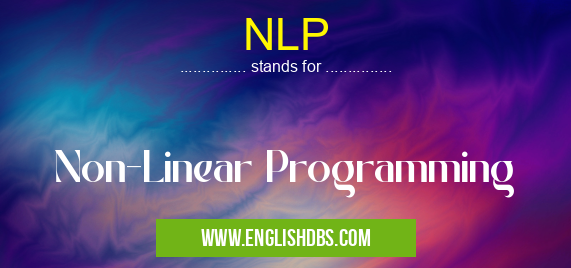What does NLP mean in MATHEMATICS
NLP stands for Non-Linear Programming in the field of Science. It is a type of mathematical optimization technique used to determine the best outcome in complex problems that cannot be solved using linear programming. NLP is used to identify the best possible solution from various possibilities and tries to find a balance between maximizing goals and minimizing constraints. This approach is used in many areas, including industrial engineering, financial modeling, system design, and decision making.

NLP meaning in Mathematics in Academic & Science
NLP mostly used in an acronym Mathematics in Category Academic & Science that means Non-Linear Programming
Shorthand: NLP,
Full Form: Non-Linear Programming
For more information of "Non-Linear Programming", see the section below.
Meaning
Non-Linear Programming is a powerful problem-solving tool designed to maximize or minimize specific values while considering constraints on all possible outcomes. It helps us identify the most efficient solutions when contemplating multiple objectives that need to be balanced. In this way it can help us make better decisions quickly and accurately by thoroughly exploring all potential options.
Application
Non-Linear Programming can be applied to solve various problems from different fields such as Industrial Engineering, Financial Modeling, System Design, Decision Making etc. One typical example is its use in the design of manufacturing plants. It can be used to identify optimal parameters such as process variables or material flows which will ensure an efficient production cycle while still meeting customer demands. NLP can also be used for scheduling problems, supply chain optimization problems or transportation network optimization issues as well as many other applications within these fields and beyond.
Essential Questions and Answers on Non-Linear Programming in "SCIENCE»MATH"
What is Non-Linear Programming?
Non-Linear Programming (NLP) is a type of optimization problem which involves minimizing or maximizing an objective function that isn't linear. It can be used to solve complex problems with multiple constraints, making it a powerful tool for data analysis and decision making.
What are the different types of Non-Linear Programming?
There are three main types of non-linear programming problems, which are unconstrained, constrained and multi-objective optimization. Unconstrained problems involve maximizing or minimizing an objective function without any restrictions; constrained problems involve finding optimal solutions within a set of constraints; and multi-objective optimization involves optimizing multiple objectives simultaneously.
How does NLP work?
NLP algorithms search through all possible solutions to an optimization problem in order to find the optimal solution that meets the given constraints. The algorithms use various search methods such as gradient descent, simulated annealing and evolutionary algorithms to optimize the objective function and avoid local optima.
What are some of the applications for NLP?
NLP can be applied to many different types of problems, ranging from scheduling tasks in logistics to portfolio selection in finance. It is also commonly used in machine learning applications such as clustering, neural networks and support vector machines. Other applications include production management, automatic control systems and robotics.
What software is available for solving NLP problems?
There are many software programs available for solving non-linear programming problems, including open source packages such as COIN-OR, GAMS and PYOMO as well as commercial tools like MATLAB Optimization Toolbox and AMPL.
What is Lagrangian Relaxation technique?
Lagrangian relaxation is a technique used in mathematics programming that relaxes certain constraints so that a more easily solvable problem can be solved instead. It involves introducing additional variables known as multipliers into the original problem formulation that measure how much each constraint should be relaxed by.
What is Quadratic Programming (QP)?
Quadratic Programming (QP) is a type of numerical optimization problem involving quadratic functions with linear equality or inequality constraints just like regular non-linear programming (NLP). The difference between QP and NLP lies in how they handle their objective functions – QP deals only with quadratic functions while NLP handles any combination of polynomial functions up to second order polynomials.
Are there any limitations on using NLP techniques?
Yes, some challenges occur when trying to employ non-linear programming techniques due to numerical instabilities arising from high dimensional spaces or even ill conditioned matrices which lead to poor performance issues becoming apparent during run time..
Final Words:
In summary, Non-Linear Programming (NLP) is an important tool in many fields which helps us optimize complex systems ranging from engineering processes to financial models or decision making scenarios. By using this approach we can more accurately assess the tradeoffs between different constraints and objectives which are necessary when trying to provide the best possible solution for any given problem.
